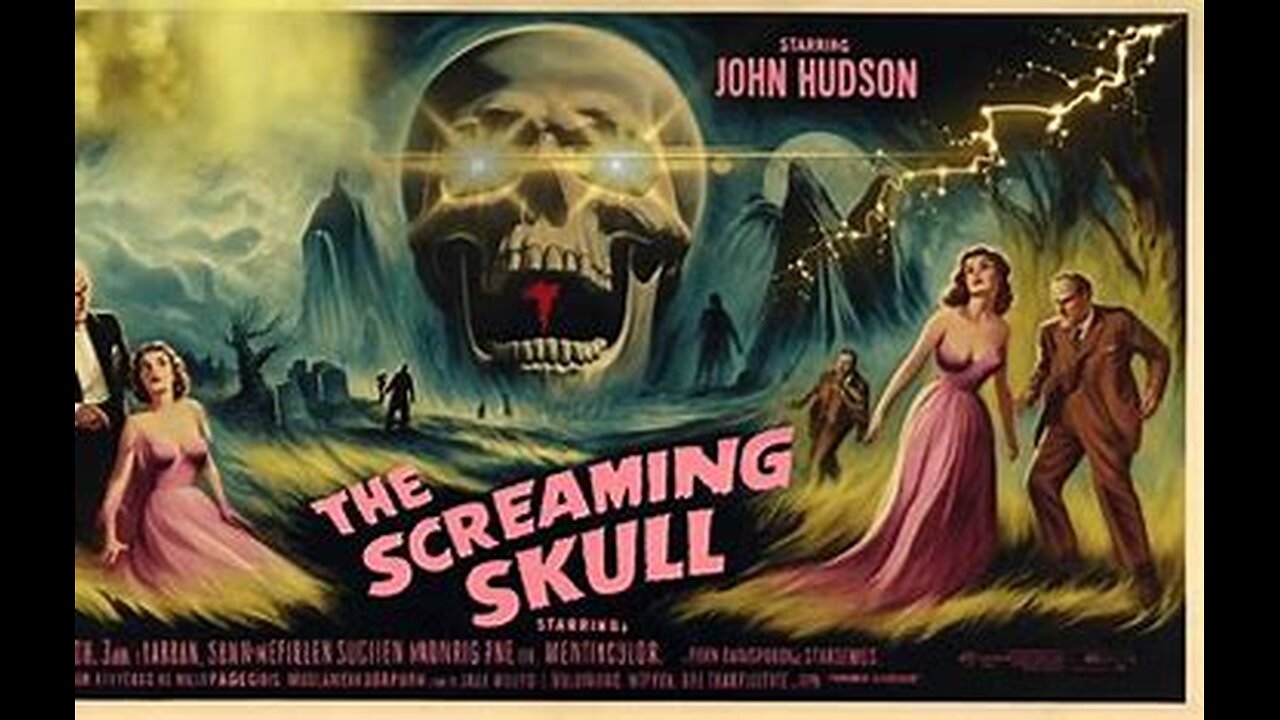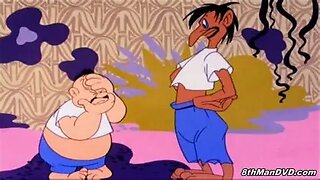Premium Only Content

The Screaming Skull (Horror Thriller, 1958)
The Screaming Skull blends creepy supernatural elements with psychological suspense, characteristic of 1950s drive-in cinema.
Plot:
Newlyweds Eric and Jenni Whitlock move into Eric’s eerie Southern mansion, where his first wife, Marianne, died in a mysterious accident by drowning in a pond after hitting her head. Jenni, who has a history of mental instability, begins experiencing disturbing events: strange noises, visions of a skull, and encounters with Marianne’s portrait, which resembles her mother. As Jenni finds the titular skull repeatedly appearing—on the lawn, in a closet, and elsewhere—she questions her sanity. Eric dismisses her fears, suggesting the estate’s gardener, Mickey, who was devoted to Marianne, might be playing tricks. However, it’s revealed that Eric is gaslighting Jenni, hiding the skull to drive her insane, possibly to kill her for her wealth. The situation escalates when Jenni sees Marianne’s ghostly figure, and Eric’s plan unravels. In a supernatural twist, Marianne’s ghost and the skull haunt Eric, chasing him to his death in the pond. Jenni is rescued by Reverend Snow and his wife, who suspect Eric may have also killed Marianne. The film ends with the mystery of Marianne’s death unresolved.
Cast:
John Hudson as Eric Whitlock: The scheming husband with a sinister agenda.
Peggy Webber as Jenni Whitlock: The vulnerable, neurotic wife who carries the emotional weight of the film.
Russ Conway as Reverend Edward Snow: A supportive local minister.
Toni Johnson (credited as Tony Johnson due to a misspelling) as Mrs. Snow: The reverend’s wife.
Alex Nicol as Mickey: The gardener, also the film’s director, playing a mentally challenged character loyal to Marianne.
Fun Facts:
Gimmick Inspiration: The film opens with a narrator warning that the climax is so terrifying it might kill viewers, offering a “free burial service” to anyone who dies of fright. This was inspired by William Castle’s Macabre (1958), which offered life insurance to viewers, though Nicol didn’t actually secure an insurance company for the stunt.
Public Domain Status: Despite an onscreen copyright notice for Madera Productions, the film was never registered with a copyright office, making it public domain. This has led to numerous DVD releases by companies like Alpha Video and Mill Creek Entertainment.
Low Budget: Shot in six weeks at the Huntington Hartford estate on a tight budget, each actor was paid $1,000 plus a promise of profit shares, which American International Pictures never paid.
Literary Roots: The film is loosely based on a horror story by Francis Marion Crawford, inspired by folklore about a “screaming skull” at Bettiscombe Manor in Dorset, England, said to belong to a slave whose spirit caused disturbances.
Directorial Debut: Alex Nicol, primarily an actor, made his directorial debut with this film because he was frustrated with the roles he was getting. He also played Mickey, speaking mostly in monosyllables to simplify his dual role.
Mystery Science Theater 3000: The film was mocked in a 1998 episode of MST3K, with critics like Bill Corbett calling it torturous, though it’s a cult favorite for its campy charm.
Production Flaws: The special effects are notoriously cheap, with a visible stick tipping the skull down stairs in one scene, and the skull’s screams sounding like they belong in a Godzilla film.
Rebecca Ruse: To convince Peggy Webber to star, Nicol claimed the film was a remake of Hitchcock’s Rebecca, even showing her a script at her home.
Crosby Connection: Cinematographer Floyd Crosby, father of musician David Crosby (of Crosby, Stills & Nash), lent a moody atmosphere despite the low budget.
Cult Appeal: Despite negative reviews (e.g., Leonard Maltin called it “dreary”), some fans on X praise its creepy vibe and 1950s B-movie charm, with one user joking about the “rubber skull” stealing the show.
Additional Notes:
The film’s 68-minute runtime, simplistic dies irae-centered score, and minimal cast (five actors) contribute to its claustrophobic, campy feel. While it’s often criticized for poor effects and a predictable plot, its Gothic atmosphere and twist ending make it a nostalgic gem for fans of vintage horror.
-
 6:42
6:42
Silver Screen Echoes
25 days agoWackiki Wabbit (Bugs Bunny Cartoon, 1943)
85 -
 2:22:52
2:22:52
Steven Crowder
5 hours agoDonald Vs. Ilhan: Trump Boots Somalis and The Meltdown is Glorious
331K281 -

Sean Unpaved
3 hours agoIs Lane Kiffin Staying At Ole Miss Or LEAVING For LSU? | UNPAVED
9.79K -
 29:48
29:48
The White House
3 hours agoPresident Trump and The First Lady Participate in the Thanksgiving Turkey Pardoning
24.3K15 -
 1:58:04
1:58:04
The Charlie Kirk Show
2 hours agoMark Kelly Court Martial + AI Embargo + Thanksgiving | Davis, Federer, Newcombe | 11.25.2025
56.5K15 -
 53:20
53:20
The Rubin Report
3 hours agoLara Trump Destroys Bill Maher’s Narrative w/ Facts in 1 Minute
40.9K41 -
 56:32
56:32
TheAlecLaceShow
2 hours agoGuest: Rep. Tim Burchett | Ukraine Russia Peace Deal | Trump SLAMS Seditious 6 | The Alec Lace Show
12.8K -
 LIVE
LIVE
LFA TV
16 hours agoLIVE & BREAKING NEWS! | TUESDAY 11/25/25
2,118 watching -
 1:08:44
1:08:44
VINCE
6 hours agoThe Deep State Strikes Back! (Guest Host Shawn Farash) | Episode 176 - 11/25/25 VINCE
205K142 -
 2:14:00
2:14:00
Benny Johnson
4 hours agoIt's All True, The 2024 Election Was Ready To Be Rigged. The REAL Story of How Trump-Elon STOPPED It
75.5K91